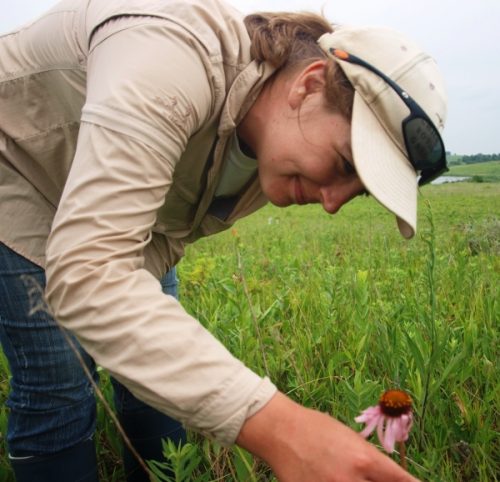
Education and Academic Positions
Assistant Professor in Plant Ecology, The College of Wooster, 2015-present
Visiting Assistant Professor at Wittenberg University & Wabash College, 2013-2015
Postdoctoral Fellow, University of Toronto, 2010-2013
Ph.D., Biological Sciences, University of Illinois at Chicago/Chicago Botanic Garden, 2010
B.A., Biology, St. Olaf College, 2003
Website: http://isonlab.voices.wooster.edu
Twitter: @IsonJenniferL
Background and Research Interests
I’ve collaborated with the Echinacea project for many years (before there was even a flog!). I started as a Team Member back in 2003 after graduating from St. Olaf College. After few years, I started my dissertation research on Echinacea. After completing my dissertation, I took a few years off the Echinacea Project to work on a plant that takes 30 days (instead of 7 years) to flower. However, I couldn’t stay away from Echinacea and have been examining Echinacea‘s pollinators since 2013.
My research interests are in ecology, conservation biology, and ecological genetics. I study how anthropogenic (i.e., human-induced) alterations to natural areas are impacting native plant populations. In North America, nearly all of our natural areas have been fragmented, and many populations are small and isolated. In fact, less than 1% of the pre-settlement prairie remains. The fragmentation and loss of habitats mean that the remaining native plant populations are often subject to the ecological and genetic consequences of small population sizes. My research examines how flowering time, plant density, and pollinator taxa affect population persistence across a fragmented landscape.
My Primary Research for Summer 2018:
How Do Solitary Bee Taxa Differ in Their Contribution to the Male and Female Fitness of a Native Prairie Plant?
Reproduction in flowering plants is particularly vulnerable to fragmentation and the loss of insect pollinators. Typically plants with hermaphroditic flowers have mechanisms that reduce the likelihood of pollination within the same flower and require a vector (i.e., wind or pollinator) for successful sexual reproduction. Native solitary bees are common pollinators for many plants species. However, pollination research has mainly focused on large social bees—bumblebees and the non-native honeybee. In addition, most studies only quantify seed set (i.e., the female fitness of a plant), thus ignoring fitness contributions from siring seeds (i.e., the male fitness of a plant).
This summer we will quantify how four generalist solitary bee taxa contribute to total male fitness in a mate-limited prairie plant, Echinacea angustifolia. We will also compare how each pollinator taxon varies in its relative contribution to a plant’s male and female fitness. To quantify male and female fitness, we will use a combination of a novel manipulative field experiment and previously developed genetic tools. This summer’s research will build on previous pollination research by College of Wooster thesis students. In 2016, Leah Prescott ‘17, Laura Leventhal ‘18, Alyson Jacobs ‘17, and Alex Hajek ‘17 found that Echinacea’s pollinator community changes over the course of the flowering season (see: Ison, JL, LJ. Prescott, SW Nordstrom, A Waananen, and S Wagenius. 2018. Pollinator-mediated mechanisms for increased reproductive success in early flowering plants. Oikos. doi:10.1111/oik.04882)
